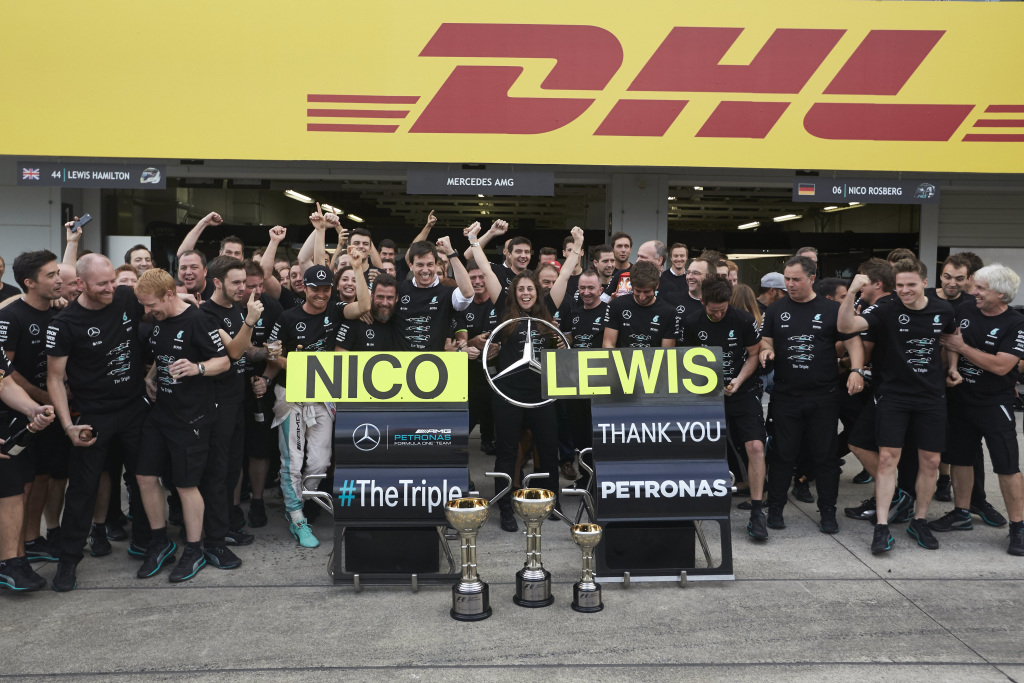The Mercedes AMG F1 Team is now the dominant force in Formula 1 after returning to the sport from which it had been absent for over half a century. How did they get there? The team has only seemed to have been in existence since 2010, but this is only a small part of a long story stretching back to the Tyrrell team. And to the Mercedes partnership with Peter Sauber and his fledgling outfit.
The Tyrrell Formula One team, established in 1970 by Ken Tyrrell, had its greatest period when Jackie Stewart drove the team to three Drivers’ crowns and one Constructors’ trophy. They were also the team that brought us the six wheeled Tyrrell P34, a car that was so radical it was banned almost immediately and now is part of Formula 1 folklore. Unfortunately they never really reached those heights again and became also-rans, eventually selling out to the BAR tobacco company.
In 1993 after partnering Sauber to success in other motor racing categories including Le Mans, Mercedes—using their Ilmor badge—supplied the Sauber F1 team with engines. In 1994 Mercedes made it official and the team became Sauber-Mercedes with the 3.5 Litre V10 C13 (all Peter Sauber cars are badged “C” after his wife Christine) At the end of the traumatic ’94 season Mercedes, tempted by an offer from Ron Dennis, moved on to McLaren, where they went on to win three Drivers’ crowns: two for Mika Häkkinen from 1998–99 and Lewis Hamilton in 2008, and a Constructors’ trophy in 1998.
In 1999 British American Tobacco came into the sport as BAR (British American racing) with a big budget and even bigger ambitions, running the Supertec engine, the rebadged and once all-conquering Renault power plant.
In their first year and with the reigning world champion Jacques Villeneuve, and despite a move to Honda power, the project was doomed to failure, and after only six years and no wins, tobacco advertising was banned from F1 and BAR sold out to Honda in 2006.
Honda with Jenson Button as lead driver looked a much more promising prospect. They brought in Ross Brawn in 2007 from the dominant Scuderia Ferrari; a man with a proven track record of building winning teams.
Alas, once again the outfit was thrown into chaos and in 2008 with a worldwide recession Honda was unwilling to continue with its $300 million budget and announced its withdrawal from Formula 1. The team was eventually saved by a management buyout headed by Ross Brawn and Nick Fry and was renamed Brawn GP; and with help from up and down the pit lane, not least from Mercedes, they where able to run in the 2009 season. What followed was one of the greatest stories in Formula 1: a true rags to riches tale; a team on the brink of disappearing, turning into a World Championship-winning success
With the now-banned double diffuser (a clever reading of the rules to enhance the downforce effect of the rear diffuser) Brawn GP took the season by storm with Jenson Button winning six of the first seven races and winning the Drivers’ title—and along with Rubens Barrichello, landed the Constructors’ title for Brawn in their maiden and only year of competition. On the 16th of November 2009 it was announced that Daimler AG and Aabar investments had bought a 75.1% stake in Brawn GP and that they would race under the name Mercedes GP from 2010. They brought in an impressive driver pairing, bringing Michael Schumacher out of retirement to partner Nico Rosberg. After deciding to finally close the curtains on his record breaking career Schumacher was replaced with the last man to win a championship with a Mercedes engine, Lewis Hamilton.
The 2014 season had been as dominant as the Fangio–Moss days of the early 1950s. More success followed in 2015 with consecutive Drivers’ and Constructors’ titles for Lewis Hamilton followed by Nico Rosberg’s success in 2016.
This year looks like shaping up to be a battle royal between Hamilton’s Mercedes and Vettel’s Ferrari.
Mercedes have truly lived up to the legendary Silver Arrows team.
Will they conquer this term? I’m betting they will.

